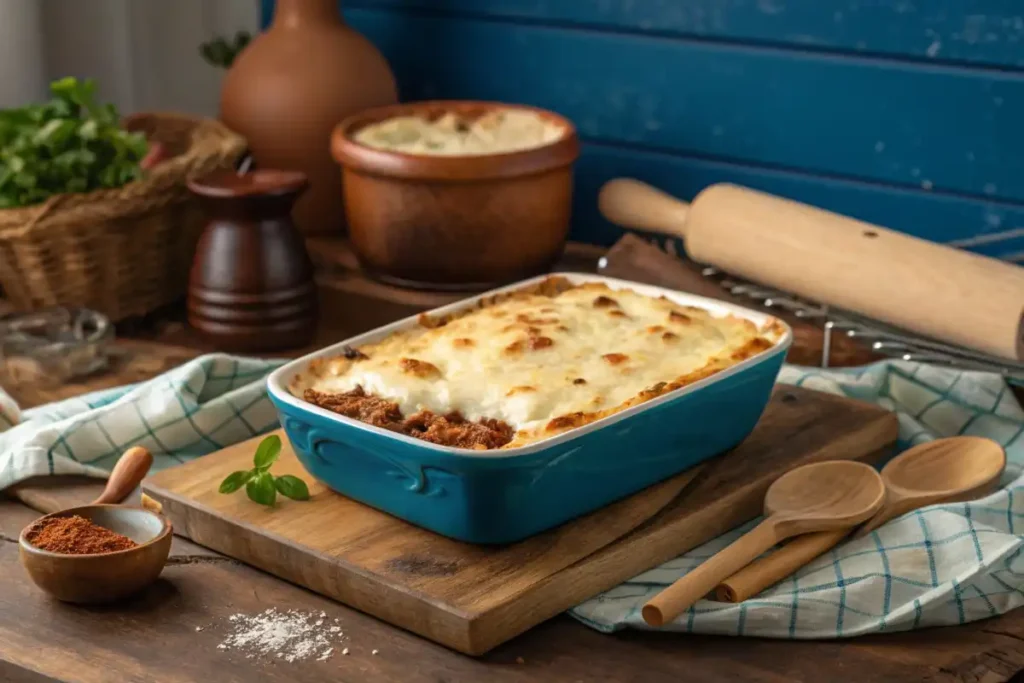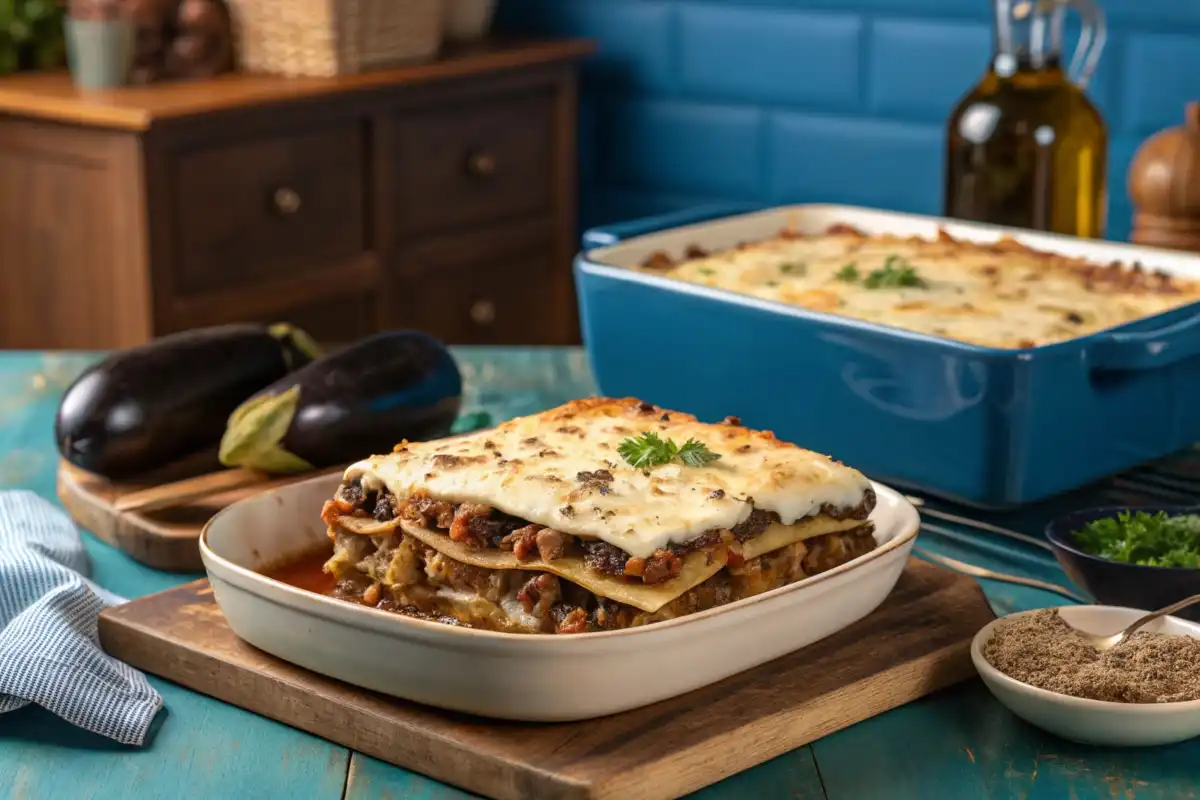Musakka stands out as a rich, layered dish cherished across Mediterranean and Middle Eastern cuisines. At the present time, many people recognize musakka as a comfort food that brings together tender eggplants, hearty ground meat, and a creamy béchamel layer. In contrast to other casserole-style meals, this dish emphasizes the natural flavors of vegetables and spices.
Therefore, it offers a unique depth of taste. Furthermore, musakka has origins in both Greek and Middle Eastern traditions, making it a favorite for countless families.
In addition, its popularity continues to grow in the United States as more people discover its appeal.
To demonstrate its versatility, musakka can adapt to various dietary needs, allowing you to find a version that suits your family’s tastes. Above all, musakka represents culinary unity, blending flavors from multiple cultures. Because of this, it feels both familiar and exotic.
What is Musakka?
Musakka, often spelled “moussaka,” is a layered dish featuring eggplant as the key ingredient. First, you have tender slices of roasted or fried eggplants.
Next, you add a savory mixture of ground meat—often lamb or beef—lightly seasoned with spices and onions.
Then, you top it off with a creamy béchamel sauce for a rich finish. In contrast to lasagna, which uses pasta sheets, musakka relies on eggplant slices to create structure. At the present time, many variations exist worldwide, reflecting local tastes.
For instance, Greek versions often include cinnamon and nutmeg, whereas Middle Eastern takes might add tomatoes and spices like allspice.
To sum up, the recipe’s base elements—eggplant, seasoned meat, and creamy topping—remain constant, yet details vary, resulting in a broad range of flavor profiles.
History and Cultural Roots of Musakka
The origins of musakka trace back centuries. Because the Mediterranean region has seen cultural exchanges and shifting borders, dishes like musakka absorbed influences from multiple cuisines. I
n particular, the Greek style gained international fame, yet Middle Eastern communities also claim a long tradition.
Eventually, as trading routes expanded, ingredients like eggplants spread across the region, helping musakka evolve.
Therefore, it represents a tapestry of flavors, bridging cultural identities. At the present time, you can find musakka in Greece, Turkey, Egypt, Lebanon, and beyond.
In addition, immigrant communities introduced musakka to the United States, allowing home cooks to experiment and adapt traditional recipes with local ingredients.
In conclusion, the dish symbolizes culinary fusion, connecting people through taste.
Why Musakka Deserves a Place in Your Kitchen
Musakka provides a warm, comforting meal for your family. In addition, it impresses dinner guests who appreciate both flavor and presentation. For instance, layers of softened eggplant and seasoned meat topped with a velvety sauce create a stunning plate.
Furthermore, it allows customization. You can choose lean ground beef or lamb, incorporate vegetarian substitutes, or tweak spices. Because it’s a baked casserole-style dish, musakka suits meal prep, as you can assemble it ahead and bake when needed. Moreover, you can freeze leftovers for another day.
In brief, musakka is practical, delicious, and adaptable.
Ingredients for the Perfect Musakka
Crafting the best musakka involves selecting high-quality ingredients. At the present time, U.S. grocery stores carry all you need. Consider these essential components:
- Eggplants: Choose firm, medium-sized eggplants with smooth, shiny skin.
- Ground Meat: Opt for lean ground lamb or beef. Lamb provides a richer taste, while beef offers a lighter flavor.
- Onions and Garlic: These aromatics form the base of the meat sauce.
- Tomatoes or Tomato Sauce: They add moisture, acidity, and depth of flavor.
- Spices: Consider cinnamon, allspice, nutmeg, salt, pepper, and dried oregano. For example, a small pinch of cinnamon adds warmth.
- Béchamel Sauce: Butter, flour, and milk create a creamy topping. Adding cheese like Kefalotyri or Parmesan is optional.
- Olive Oil: Use extra-virgin olive oil to enhance taste and texture.
- Fresh Herbs: Parsley or mint can lighten the dish and add freshness.
In contrast to other layered casseroles, the focus remains on vegetables and subtle spices. Therefore, it’s essential to pick ingredients that harmonize together.
Preparing and Cooking Musakka
Preparing musakka involves several stages. However, once you master the process, you will find it easier with every attempt.
Preparing the Eggplants
- Slice the Eggplants: Cut eggplants lengthwise into 1/4-inch-thick slices.
- Salt and Drain: Sprinkle with salt to draw out moisture. Let them sit for about 30 minutes. This reduces bitterness.
- Pat Dry: Rinse slices under cool water and pat dry with a paper towel.
- Cook the Eggplants: Grill, bake, or lightly fry the slices in olive oil until tender. For a lighter version, brush them with oil and roast at 400°F until golden. In contrast to frying, roasting uses less oil.
Making the Meat Sauce
- Sauté Aromatics: In a large pan, cook diced onions in olive oil until translucent. Add minced garlic.
- Add Meat: Add the ground lamb or beef, breaking it up as it cooks. Stir until browned.
- Seasonings: Mix in salt, pepper, cinnamon, and oregano. For instance, add a pinch of cinnamon to create a warm aroma.
- Tomato Sauce: Pour in crushed tomatoes or tomato sauce. Simmer until thickened.
- Taste and Adjust: Sample the mixture and adjust spices as needed.
Preparing the Béchamel Sauce
- Melt Butter: In a saucepan, melt butter over medium heat.
- Add Flour: Whisk in flour until it forms a smooth paste.
- Add Milk Gradually: Pour in warm milk slowly, whisking constantly to avoid lumps.
- Season Lightly: Add salt, pepper, and a pinch of nutmeg. For example, a small amount of nutmeg complements the creamy sauce.
- Thicken: Stir until the sauce thickens to a pourable consistency. Remove from heat.
Assembling the Musakka
- Layer Eggplants: Spread a layer of cooked eggplants at the bottom of a greased baking dish.
- Add Meat Sauce: Spoon a layer of the meat mixture over the eggplants.
- Second Layer of Eggplants: Top with another layer of eggplants to seal in the meat.
- Pour Béchamel: Pour the béchamel sauce evenly over the top layer.
- Optional Cheese: Sprinkle grated cheese on top for extra flavor and texture.
- Bake: Bake in a preheated oven at 350°F for about 45-60 minutes until the top turns golden and the dish bubbles around the edges. Let it rest for 15 minutes before slicing to allow the layers to settle.

Nutritional Information for Musakka
The nutritional profile of musakka varies based on ingredients and serving size. Because many prepare musakka with lean meat and roasted eggplants, it can be quite balanced. Below is an approximate nutritional breakdown per serving (one portion out of eight):
| Nutrient | Approx. Amount per Serving |
|---|---|
| Calories | 340 kcal |
| Protein | 20 g |
| Fat | 20 g |
| Carbs | 20 g |
| Fiber | 5 g |
| Sodium | 600 mg |
Keep in mind that nutritional values differ depending on your chosen meat, cheese, and cooking methods.
Tips for Perfecting Your Musakka
- Choose Fresh Eggplants: Fresh, firm eggplants improve texture and flavor.
- Drain Excess Moisture: Salting and draining eggplants ensures a firmer final dish.
- Control the Oil: For a lighter version, roast instead of frying.
- Balance Spices: Add warm spices slowly, tasting as you go. Too much cinnamon can overwhelm.
- Rest Before Serving: Let musakka sit after baking, so the layers hold together when sliced.
Variations of Musakka
Musakka enjoys multiple interpretations:
- Vegetarian Musakka: Omit the meat and add hearty lentils, mushrooms, or chickpeas. In addition, use vegetable broth for the sauce.
- Vegan Musakka: Replace béchamel with a plant-based white sauce. For instance, use almond milk and vegan butter.
- Light Musakka: Use turkey or lean beef, roast eggplants, and skip the cheese.
- Spicier Version: Add a small amount of chili flakes or paprika to the sauce for extra heat.
- Cheesier Top: Mix grated cheese into the béchamel for a richer taste.
Serving Suggestions
Musakka tastes best served warm with a side salad or crusty bread. Moreover, consider pairing it with roasted vegetables or a simple cucumber yogurt sauce. In contrast to heavier sides, light and fresh accompaniments highlight the flavors of musakka.
Because the dish itself is quite filling, a crisp salad balances the meal.
Additionally, consider adding a drizzle of extra-virgin olive oil on top before serving.
The creamy and savory layers make it a comforting main course ideal for family dinners, holiday feasts, or potluck gatherings.

Storing and Reheating Musakka
Musakka keeps well in the refrigerator for up to three days. For longer storage, freeze portions in airtight containers.
When reheating, use the oven to preserve texture and flavor. For instance, cover with foil and reheat at 350°F until warmed through. Because the flavors mingle over time, some even claim it tastes better the next day.
Health Benefits of Musakka
Eggplants provide fiber, which supports digestion and heart health. In addition, lean meats supply protein and iron.
The tomatoes offer vitamins A and C. Moreover, controlling the fat content by roasting eggplants and using lean meats can make musakka a nutrient-dense meal.
Therefore, it fits well into a balanced diet. In contrast to fried foods, lighter cooking methods enhance its health profile. Furthermore, pairing it with a side salad adds more vitamins and minerals.
Common Mistakes to Avoid
- Skipping the Salting Step: Not salting the eggplants can lead to a watery, bitter dish.
- Over-Spicing: Adding too many spices masks the natural flavors.
- Too Much Oil: Over-frying eggplants soaks them in oil, making the dish heavy.
- Impatient Slicing: Cutting into musakka right out of the oven causes it to fall apart. Let it rest.
- Not Adjusting Seasonings: Taste often. Adjust salt and spices as the sauce simmers.
Pairing Musakka with Other Dishes
Try pairing musakka with a side of herbed rice, roasted vegetables, or a light quinoa salad. In addition, a dollop of tzatziki or a lemony yogurt sauce brightens the flavors.
For instance, a crisp green salad with cherry tomatoes and a simple vinaigrette contrasts nicely with the rich casserole. Because musakka is satisfying, simple sides keep the meal balanced.
Frequently Asked Questions (FAQs)
Q: Is moussaka Greek or Arab?
A: Musakka has roots in both Greek and Middle Eastern cuisines. Because the dish appears in various forms across these regions, it’s a shared culinary treasure. In conclusion, it’s not solely Greek or Arab…
Q: Is moussaka just lasagna?
A: Musakka is not lasagna. In contrast to lasagna’s pasta layers, musakka uses eggplants. Furthermore, the flavor profile differs due to spices and béchamel sauce. Therefore, it offers a distinct taste and texture…
Q: Is moussaka healthy?
A: Musakka can be healthy if prepared with lean meats, less oil, and more vegetables. In addition, roasting eggplants instead of frying reduces fat. Therefore, it can fit into a balanced diet…
Q: What is aubergines in Italian?
A: Aubergines are called “melanzane” in Italian…
Q: Can I make musakka ahead of time?
A: Yes, you can assemble it in advance and refrigerate. In the meantime, preheat the oven before baking. This makes it a perfect option for dinner parties.
Q: Can I freeze leftover musakka?
A: Yes. Cool it completely and store in airtight containers. Because it reheats well, it’s a great meal-prep dish.
Q: Can I use other vegetables instead of eggplants?
A: Yes. For instance, zucchini or potatoes can add variety. In addition, you can combine eggplants with these vegetables for a unique twist.
Conclusion to Musakka
In conclusion, musakka is a comforting, flavorful dish that reflects the rich heritage of the Mediterranean and Middle Eastern regions.
Because it combines layers of tender eggplants, seasoned meat, and a creamy topping, it delights both the palate and the eye. Furthermore, it’s adaptable to various dietary needs.
For instance, you can make it vegetarian or lighten the recipe by roasting the eggplants. In addition, musakka pairs well with fresh salads, yogurt sauces, or simple sides.
Therefore, it stands as a versatile and satisfying meal that deserves a place in your recipe collection. Above all, musakka represents culinary unity, offering a taste of history and culture on every plate.
